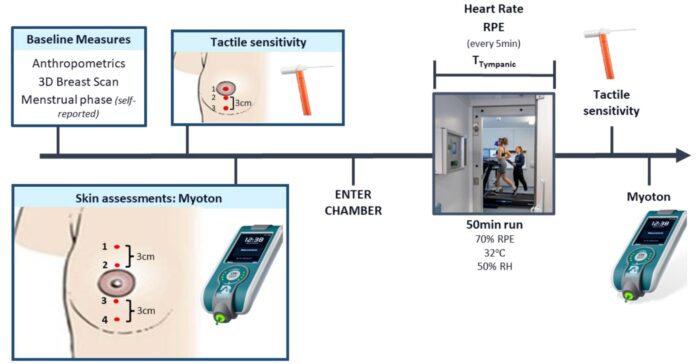Publications

The effect of female breast surface area on skin stiffness and tactile sensitivity at rest and following exercise in the heat
Authors: Hannah Blount 1, Alessandro Valenza 1, 2, Jade Ward 1, Silvia Caggiari 3, Peter R. Worsley 3, Davide Filingeri 1
Affiliations:
- ThermosenseLab, Skin Sensing Research Group, School of Health Sciences, The University of Southampton, Southampton, UK
- Sport and Exercise Sciences Research Unit, SPPEFF Department, University of Palermo, Palermo, Italy
- PressureLab, Skin Sensing Research Group, School of Health Sciences, The University of Southampton, Southampton, UK
Journal: Experimental Physiology - October 2024, Volume 109, Issue 10, Pages 1698-1709 (DOI: 10.1113/EP091990)
-
Field & Applications:
- Sport
- Women's health
- Skin / Dermatology
- Product development
Female development includes significant morphological changes across the breast. Yet, whether differences in breast surface area (BrSA) modify breast skin stiffness and tactile sensitivity at rest and after exercise in the heat remain unclear.
We investigated the relationship between BrSA and skin stiffness and tactile sensitivity in 20 young to middle-aged women (27 ± 8 years of age) of varying breast sizes (BrSA range: 147–502 cm2) at rest and after a submaximal run in a warm climatic chamber (32C ± 0.6C; 53% ± 1.7% relative humidity). Skin stiffness above and below the nipple and tactile sensitivity from the nipple down were measured. Associations between BrSA and both skin stiffness and tactile sensitivity at rest were determined via correlation analyses. Effects of exercise and test site were assessed by a two-way ANOVA.
Skin stiffness was positively correlated with BrSA 3 cm above the areola edge (r = 0.61, P = 0.005) and at the superior areola border (r = 0.54, P = 0.016), but not below the nipple (P > 0.05). The area 3 cm below the areola was also significantly stiffer than all other test sites (P < 0.043). Tactile sensitivity did not vary with BrSA (P > 0.09), but it varied across the breast (i.e., the area 3 cm below the areola was more sensitive than the inferior areola edge; P = 0.018). Skin stiffness and tactile sensitivity across the breast decreased after exercise by ∼37% (P < 0.001) and ∼45% (P = 0.008), respectively.
These findings expand our fundamental understanding of the mechanosensory properties of the female breast, and they could help to inform sportswear innovation to better meet the support needs of women of different breast sizes at rest and following exercise.

Keywords: breast, exercise, female, skin mechanics, tactile sensation
The results of this study demonstrate a dynamic interplay between breast size, skin stiffness, tactile sensitivity and exercise. Breast size-dependent differences in skin stiffness exist in the upper breast at rest, such that the larger the breast, the greater the skin stiffness. Further research is required to investigate whether this effect impacts tactile sensitivity in this region. Exercise in the heat led to reduced skin stiffness and tactile sensitivity to a meaningful extent (i.e., between ∼37% and 45%). These findings expand our fundamental understanding of mechanical and sensory properties of the breast. Furthermore, this knowledge could help to inform sports bra design that better meets the support needs of the skin of the upper breast in women of different breast sizes, both at rest and after exercise in the heat.


